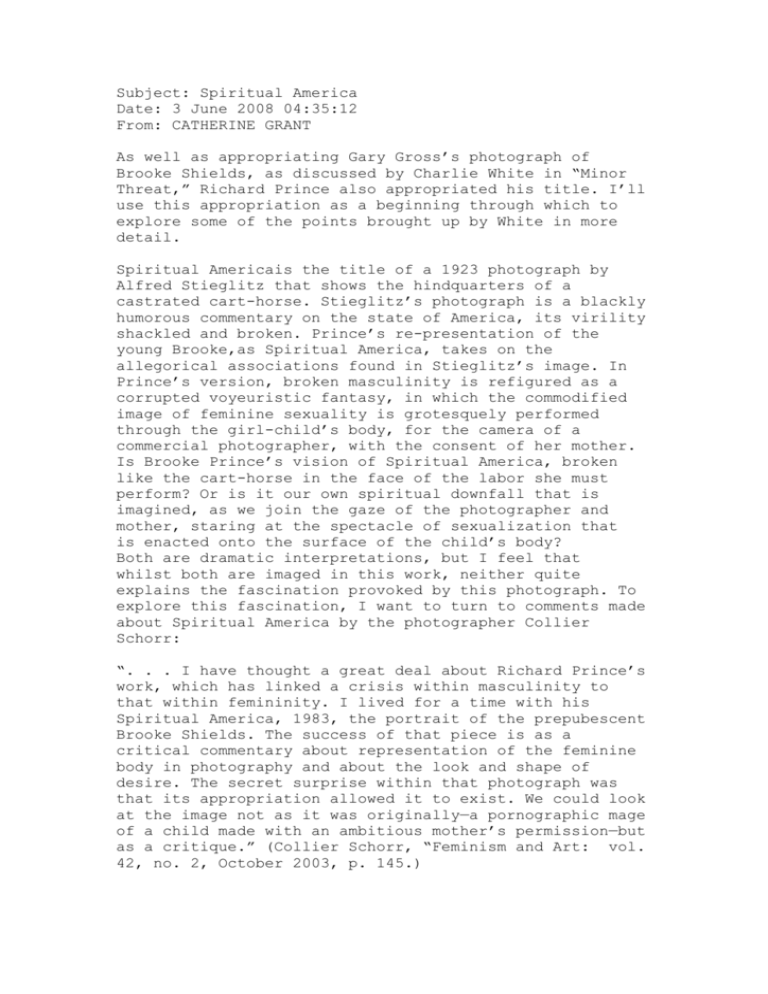rather adolescent
advertisement

Subject: Spiritual America Date: 3 June 2008 04:35:12 From: CATHERINE GRANT As well as appropriating Gary Gross’s photograph of Brooke Shields, as discussed by Charlie White in “Minor Threat,” Richard Prince also appropriated his title. I’ll use this appropriation as a beginning through which to explore some of the points brought up by White in more detail. Spiritual Americais the title of a 1923 photograph by Alfred Stieglitz that shows the hindquarters of a castrated cart-horse. Stieglitz’s photograph is a blackly humorous commentary on the state of America, its virility shackled and broken. Prince’s re-presentation of the young Brooke,as Spiritual America, takes on the allegorical associations found in Stieglitz’s image. In Prince’s version, broken masculinity is refigured as a corrupted voyeuristic fantasy, in which the commodified image of feminine sexuality is grotesquely performed through the girl-child’s body, for the camera of a commercial photographer, with the consent of her mother. Is Brooke Prince’s vision of Spiritual America, broken like the cart-horse in the face of the labor she must perform? Or is it our own spiritual downfall that is imagined, as we join the gaze of the photographer and mother, staring at the spectacle of sexualization that is enacted onto the surface of the child’s body? Both are dramatic interpretations, but I feel that whilst both are imaged in this work, neither quite explains the fascination provoked by this photograph. To explore this fascination, I want to turn to comments made about Spiritual America by the photographer Collier Schorr: “. . . I have thought a great deal about Richard Prince’s work, which has linked a crisis within masculinity to that within femininity. I lived for a time with his Spiritual America, 1983, the portrait of the prepubescent Brooke Shields. The success of that piece is as a critical commentary about representation of the feminine body in photography and about the look and shape of desire. The secret surprise within that photograph was that its appropriation allowed it to exist. We could look at the image not as it was originally—a pornographic mage of a child made with an ambitious mother’s permission—but as a critique.” (Collier Schorr, “Feminism and Art: vol. 42, no. 2, October 2003, p. 145.) This idea that Prince’s appropriation “allows” us to look at this image provides a point of access that does not collapse into the Orwellian policing of acceptable boundaries of image production. Thisembedding of critique, combined with fascination for the figure of the adolescent (for I think it is the adolescent that this image evokes, rather than the child), is a combination that drives many images of teens in contemporary art. For me, this image evokes the adolescent because of the way in which it sits alongside Brooke Shields’s later successes, and the timing of its re-presentation in the early eighties as Sheilds edged towards adulthood. As White explores, Brooke Shields’s Calvin Klein adverts are refigured in the face of this earlier image, the unacceptable pedophilic framing of her 10-year-old body tainting the barely legal sexualization of her adolescent self. Importantly, Spiritual America is not only the title of Prince’s photograph, but also the gallery he set up to sell prints of the image as a mocking commentary on the legal battles taking place at the time between Shields’s mother and Gross, as the photographer tried to capitalize on the teen star’s fame by issuing the image as a limited edition print. Here the sexualized body is merged with the commodified body. Schorr’s comments about living with Spiritual Americapoint to how we all live with this image, as the constantly sexualized image of youth is a staple of our media, albeit glossed in terms of an adolescent, rather than prepubescent, body. Perhaps what is fascinating about Spiritual Americais its staging of the blurred lines between acceptable and unacceptable sexuality in contemporary culture, where the figure of the adolescent stands in for our ultimate object of desire whilst hovering on the cusp of childhood, with the dangers of the pedophilic gaze that this brings. If this is the case, then what is the attraction of the adolescent and child to so many contemporary photographers? In my own writing on the representation of adolescence, the issues of consent and control, which figure so strongly in White’s article, become more ambiguous with the shift from child to adolescent. It would seem to me that there is a world of difference between Carroll’s images of Alice Liddell (age 6), Gross’s images of Shields at age 10, Rineke Dijkstra’s images of teenagers in her Beachesseries, and Collier Schorr’s collaborative projects with adolescents in Germany. For me, the interest is in the way that control is negotiated by the adolescent sitter, and how the power dynamic of photographer/viewer and sitter is dramatized in a way that demonstrates that we are all controlled to some extent by the gaze of others. However, this power dynamic is not one that is unshakeable, and for me, the depiction of adolescence as a performance points to the myriad ways in which identities and desires can escape normative boundaries. By focusing on minors as an indistinct category,White’s text allows the specter of the predatory photographer to overshadow what is at stake in the representation of adolescence. The adolescent is a crucial figure in contemporary culture that allows critiques of the structures of desire and adult identity (although I agree with many of White’s points about the representation of minors “activating” the spectator). From Larry Clark’s provocative participant-observer photographs in his book Tulsa (1971), to Sally Mann’s image and text combinations in At Twelve (1988),to a 16-year-old Kate Moss on the cover of The Face,to the apparently unconscious staging of feminine poses (from pin-up poses to Bottecelli’s Venus) in two of the most frequently reproduced images from Dijkstra’s Beach Portraits series, an alternative history of images of adolescence needs to be imagined, complicating the trajectory from Carroll to Gross. The potential for a critique of what appears stable—from the child to the adult, to the viewer as voyeur, to the subject as passive, to the picturing of desires that can be labeled and compartmentalized—this is the fascination for me found in the images of adolescence in contemporary art. After decades of feminism, psychoanalytic theories of the gaze, queer theory and politics and an ever-expanding image culture, the use of the adolescent by artists and photographers (particularly women) provides a culturally loaded space in which to consider and critique our conceptions of identity and sexuality. If, as many psychoanalysts argue, the state of adult maturity is in itself a fantasy that is only ever partially achieved, then adolescence as a psychic space is one that we are all destined to return to, a site which is filled as much with nostalgia as with desire, a recognition of our own selves that is activated in these performances for the camera. In this way, the relationship between adult photographer and adolescent sitter is not simply one of control, but potentially of recognition and renegotiation, a reimagining that helps us to understand the allegorical implications of photographing adolescence, as pointed to by Prince’s title.






![Adolescence in 20th Century Literature and Culture [DOCX 16.08KB]](http://s3.studylib.net/store/data/006806148_1-4fb552dd69cbfa44b08b2f880802b1fe-300x300.png)


